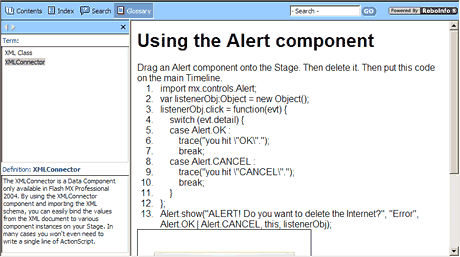Building a Glossary
Building a Glossary
The Glossary feature in RoboHelp is similar to setting up a dictionary: You can add several terms and their associated definitions. Creating a Glossary is simple:
- Click the Glossary tab in the lower left hand corner of RoboHelp
- Type the word you want to define in the Term text field and click the Add button to add glossary terms. The term that you add appears in the pane below the text field.
- Enter a definition in the Definition For text field.
You don’t need to click any Apply or OK buttons to save the content when you add definitions, because the content is saved automatically. Regenerate the primary layout and view your pages in a web browser after you add a few terms and their definitions. You see a fourth button called Glossary in the new HTML pages that you generate. Click the Glossary button to see the glossary terms.

Figure 9. Viewing the glossary in the web browser
After you publish the new files, click a term and view its definition, similar to how the interface works within RoboHelp. As if that wasn’t already impressive enough, you can even link your glossary terms to your topics using the Glossary Hotspot Wizard. Glossary words appear in a red linked text that expands the page to display the term’s definition when the user clicks it. It’s probably easier to understand what happens with Glossary words when you try it out yourself.
Before you run the Glossary Hotspot Wizard, make sure that your glossary contains at least one term (and definition) of a word that appears within your topics. You need to have at least one glossary term defined within your current project, as well as that term defined somewhere within a topic. Then follow these steps:
- Select Tools > Glossary Hotspot Wizard from the main menu. The Glossary Hotspot Wizard dialog box appears, and provides you a brief overview of what the wizard does and lets you select which folders and terms to use.
- Accept the default parameters, and click Next to proceed.
- Select the check box beside each term that you want to link to the current template, and you can see each selected word’s definition near the bottom of the dialog box.
- Depending on how many keywords were found in your existing Topics, you will either go to the next topic, or click a Finish button after no more topics are found.
- Click Finish to complete the wizard, close the dialog box, and display a Results window. The Results window provides a summary of how many topics were reviewed, how many topics have glossary terms, and a few other statistics.
Regenerate the project files again to review the results of the Hotspot wizard in a web browser. Navigate to the topic page that contains the glossary term and click the italic red text. RoboHelp automatically displays the definition of the italicized term within the page itself, in italic blue font. To hide the definition, click the italicized red font again.

Figure 10. Click glossary terms within topics to display the definition inline.
Congratulations! Your project now includes a glossary with inline collapsible definitions after only a few clicks of the mouse (and typing definitions, of course).


Comments